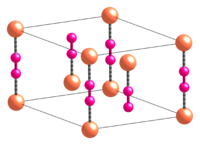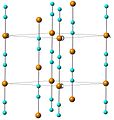- Copper(I) cyanide
-
Copper(I) cyanide  Copper(I) cyanideOther namesCuprous cyanide, copper cyanide, cupricin
Copper(I) cyanideOther namesCuprous cyanide, copper cyanide, cupricinIdentifiers CAS number 544-92-3 
PubChem 11009 ChemSpider 10543 
EC number 208-883-6 RTECS number GL7150000 Jmol-3D images Image 1 - [Cu+].[C-]#N
Properties Molecular formula CuCN Molar mass 89.563 g/mol Appearance off-white / pale yellow powder Density 2.92 g/cm3[1] Melting point 474 °C, 747 K, 885 °F
Solubility in water negligible Solubility insoluble in ethanol, cold dilute acids;
soluble in NH4OH, KCNHazards MSDS Oxford MSDS EU Index 006-007-00-5 EU classification Very toxic (T+)
Dangerous for the environment (N)R-phrases R26/27/28, R32, R50/53 S-phrases (S1/2), S7, S28, S29, S45, S60, S61 NFPA 704 Flash point Non-flammable  (verify) (what is:
(verify) (what is:  /
/ ?)
?)
Except where noted otherwise, data are given for materials in their standard state (at 25 °C, 100 kPa)Infobox references Copper(I) cyanide in an inorganic compound with the formula CuCN. This off-white solid occurs in two polymorphs; impure samples can be green due to the presence of Cu(II) impurities. The compound is useful as a catalyst, in electroplating copper, and as a reagent in the preparation of nitriles.[2]
Contents
Structure
Copper cyanide is a coordination polymer. It exists in two polymorphs both of which contain -[Cu-CN]- chains made from linear copper(I) centres linked by cyanide bridges. In the high-temperature polymorph, HT-CuCN, which is isostructural with AgCN, the linear chains pack on a hexagonal lattice and adjacent chains are off set by +/- 1/3 c, Figure 1.[3] In the low-temperature polymorph, LT-CuCN, the chains deviate from linearity and pack into rippled layers which pack in an AB fashion with chains in adjacent layers rotated by 49 °, Figure 2.[4]
LT-CuCN can be converted to HT-CuCN by heating to 563 K in an inert atmosphere. In both polymorphs the copper to carbon and copper to nitrogen bond lengths are ~1.85 Å and bridging cyanide groups show head-to-tail disorder.[5]
Preparation
Cuprous cyanide is commercially available and is supplied as the low-temperature polymorph. It can be prepared by the reduction of copper(II) sulfate with sodium bisulphite at 60 °C, followed by the addition of sodium cyanide to precipitate pure LT-CuCN as a pale yellow powder.[6]
- 2 CuSO4 + NaHSO3 + H2O + 2 NaCN → 2 CuCN + 3 NaHSO4
On addition of sodium bisulphite the copper sulphate solution turns from blue to green, at which point the sodium cyanide is added. The reaction is performed under mildly acidic conditions. Copper cyanide has historically been prepared by treating copper(II) sulfate with sodium cyanide, in this redox reaction, copper(I) cyanide forms togther with cyanogen:[7]
- 2 CuSO4 + 4 NaCN → 2 CuCN + (CN)2 + 2 Na2SO4
Because this synthetic route produces cyanogen, uses two equivalents of sodium cyanide per equivalent of CuCN made and the resulting copper cyanide is impure it is not the industrial production method. The similarity of this reaction to that between copper sulphate and sodium iodide to form copper(I) iodide is one example of cyanide ions acting as a pseudo halide. It also explains why copper(II) cyanide, Cu(CN)2, has not been synthesised.
Reactions
Copper cyanide is insoluble in water but rapidly dissolves in solutions containing CN- to form [Cu(CN)3]2- and [Cu(CN)4]3-, these ions are trigonal planar and tetrahedral respectively. This is in contrast to both silver and gold cyanides which form [M(CN)2]- ions in solution. [8] The coordination polymer KCu(CN)2 contains [Cu(CN)2]- units which link together forming helical anionic chains.[9]
Copper cyanide is also soluble in 0.88 aqueous ammonia, pyridine and N-methylpyrrolidone.
Applications
Cuprous cyanide is used for electroplating copper.[2] The compound is useful reagent in organic synthesis, for example in the regioselective and stereoselective allylation and conjugate addition of N-Boc-2-lithiopyrrolidine and N-Boc-2-lithiopiperidine,[10] or the copper cyanide catalyzed palladium coupling of α-lithio amines and aryl iodides.[11]
References
- ^ Lide, David R., ed (2006). CRC Handbook of Chemistry and Physics (87th ed.). Boca Raton, FL: CRC Press. ISBN 0-8493-0487-3.
- ^ a b H. Wayne Richardson "Copper Compounds" in Ullmann's Encyclopedia of Industrial Chemistry, Wiley-VCH, Weinheim, 2005. doi:10.1002/14356007.a07_567
- ^ S. J. Hibble, S. M. Cheyne, A. C. Hannon and S. G. Eversfield (2002). "CuCN: A Polymorphic Matirial. Structure of One Form from Total Neutron Diffraction". Inorg. Chem. 41 (20): 8040–8048. doi:10.1021/ic0257569.
- ^ S. J. Hibble, S. G. Eversfield, A. R. Cowley and A. M. Chippindale (2004). "Copper(I) Cyanide: A Simple Compound with a complicated Structure and Surprising Room-Temperature Reactivity". Angew. Chem. Int. Ed. 43 (5): 628–630. doi:10.1002/anie.200352844.
- ^ S. Kroeker, R. E. Wasylishen and J. V. Hanna (1999). "The Structure of Solid Copper(I) Cyanide: A Multinuclear Magnetic and Quadrupole Resonance Study.". Journal of the American Chemical Society 121 (7): 1582–1590. doi:10.1021/ja983253p.
- ^ H. J. Barber (1943). "Cuprous Cyanide: A Note on its Preparation and Use". J. Chem. Soc.: 79. doi:10.1039/JR9430000079.
- ^ J. V. Supniewski and P. L. Salzberg (1941), "Allyl Cyanide", Org. Synth., http://www.orgsyn.org/orgsyn/orgsyn/prepContent.asp?prep=CV1P0046; Coll. Vol. 1: 46
- ^ Sharpe, A. G. (1976). The Chemistry of Cyano Complexes of the Transition Metals. Academic Press. pp. 265. ISBN 0126384509.
- ^ Housecroft, Catherine E.; Sharpe, Alan G. (2008) Inorganic Chemistry (3rd ed.), Pearson: Prentice Hall. ISBN 978-0-13-175553-6.
- ^ Coldham, Iain; Daniele Leonori (May 14, 2010). "Regioselective and Stereoselective Copper(I)-Promoted Allylation and Conjugate Addition of N-Boc-2-lithiopyrrolidine and N-Boc-2-lithiopiperidine". The Journal of Organic Chemistry 75 (12): 4069–4077. doi:10.1021/jo100415x. PMID 20469892. http://pubs.acs.org.dblibweb.rdg.ac.uk:4000/doi/abs/10.1021/jo100415x.
- ^ Dieter, R. K.; ShengJian Li (1995). "Copper Cyanide Catalyzed Palladium Coupling of α-Lithio Amines and Aryl Iodides". Tetrahedron Letters 36 (21): 3613–3616. doi:10.1016/0040-4039(95)00577-Y.
External links
- National Pollutant Inventory - Cyanide compounds fact sheet
- National Pollutant Inventory - Copper and compounds fact sheet
Copper compounds Categories:- Copper compounds
- Cyanides
- Inorganic insecticides
- Fungicides
Wikimedia Foundation. 2010.



